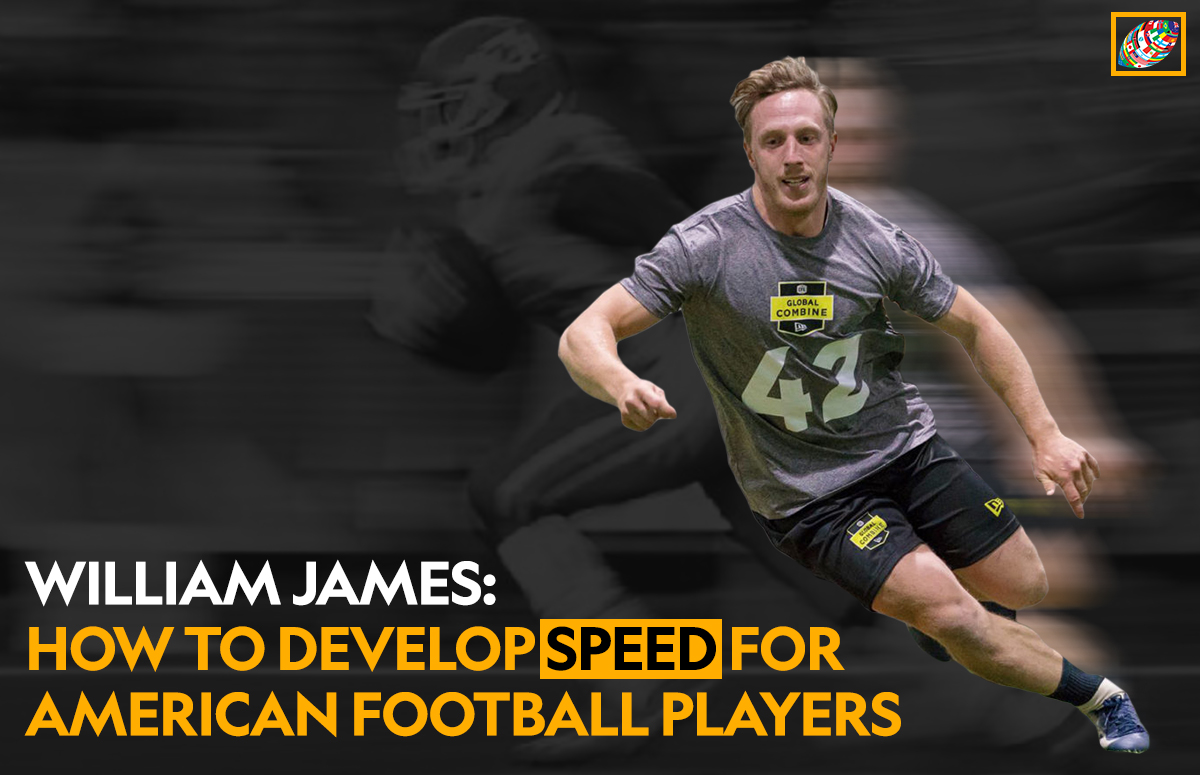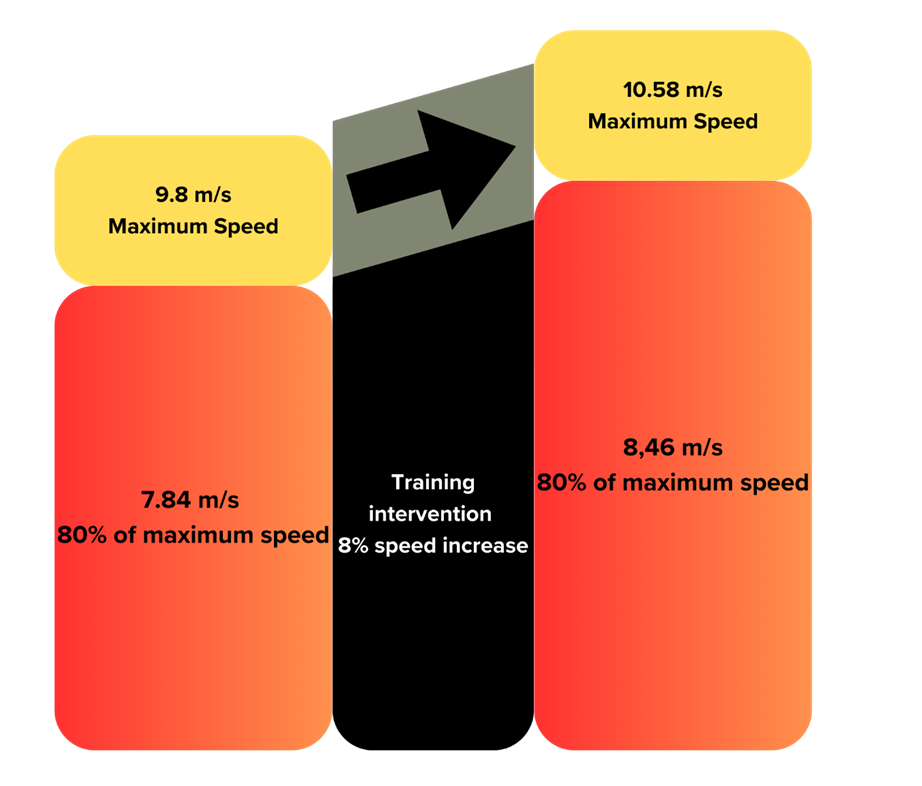How to develop speed for American football players

By William James
Introduction
Speed is key for every position on a football field. Whether that is increasing your top end speed or increasing your speed of execution for a given task, we all need speed. Luckily, speed is a skill that can be taught and developed! In this article I will be going over some ideas and a progression for speed development.
What is speed?
Speed is the goal of getting from point A to point B in as little time as possible. In track & field that means running in a straight line through the finish and in football it can be anything from a D-End getting around the edge to sack the QB, to running back a kick-off return. The principle is to get to any point of interest as fast as possible.
The demands for how speed is expressed are different in the two sports of track & field and American football. However, we can learn a lot from the first one.
Components of speed

Figure 1
Speed has many components as shown in figure 1
In this figure we can see that we can break down speed into three qualities that we need.
- Acceleration
- Max Velocity
- Speed-Endurance
Acceleration
Acceleration is simply how fast we can get up to the desired speed. In football, we have a huge demand achieve acceleration within as few steps as possible.
The easiest way to get started with acceleration training is to simply use hill sprints. Find a hill and sprint up it. Sprint anywhere from 10-60m depending on your position and what you are trying to develop. Another bonus of using hills is for the reduced impact on the joints and the body which in early off-season can be good for athletes who are coming back from a break.
Acceleration is more correlated to general strength as well, so the role of general strength does have some carry over here in helping improve the initial push-off. Ideally, we can develop this with the use of sleds, prowlers or resistance bands.
Prowlers, sleds, band resisted sprints are all viable options for gaining more specific strength since we’re using the same movement pattern and intent as we would sprinting normally. Using very heavy resisted sprints with up to 90% of your body weight has shown to have positive effects for acceleration work. So load up that prowler or sled and get to it!
Max velocity
Max velocity training in American football is simple, use a 20-30m running start and perform a flying sprint for 10-30m. If possible, set up timing gates to let athletes self-organize in figuring out what movement strategy works for them to achieve lower times. Otherwise, have a rabbit, somebody that times up the flying sprint to make it challenging for them to try and chase them down.
A common technical error we see in max velocity, and acceleration for that matter is our athletes spending too much time with their legs behind their body, leading to less favorable positions such as an arched lower back and the foot striking in front of the body’s center of mass due to a prolonged backside mechanics.
Some good modifications to fly 10’s, 20’s and 30’s is for athletes to carry a stick with straight arms in front of them to promote a neutral pelvic position or other varying objects/equipment to keep them interested and help them discover sprinting mechanics under constraints.
Speed-Endurance
From what I have seen, most coaches in American football train acceleration and some might train max velocity, but I believe few take the time train speed-endurance. Speed endurance is simply the ability to maintain your top-end speed for as long as possible. This is done by running distances that require you to maintain 90-95% of your top-end speed and they are typically very fatiguing so plan accordingly.
Speed-endurance is going to be mostly relevant for skill players and some backs. However, I wouldn’t use it with linemen due to the demands of this skill at their body mass is not worth the risk of injury, and it also has little transfer to their position demands which mostly involves being very fast for up to 20-30m.
Another huge benefit of speed-endurance is teaching athletes to be elastic. When we push the distance and intensity up, we can no longer rely on only strength and muscular power, so our body will find other strategies, and that strategy will be elasticity through tendons. Be aware that speed-endurance training is fatiguing and will require recovery.
Typical distances I’d use for American football players to develop speed-endurance would be 80-150 m and the goal is to maintain sprinting form, be relaxed and work at around 90-95% of your max effort.
Structure/function
I view the early off-season as an opportunity to teach athletes sprinting mechanics and treat them more as track athletes that need to learn how to create raw power output in their sprint. This is the exact same principle as pushing up your absolute strength, we want to push our top-end speed to have a bigger speed reserve.
Derek Hansen popularized the concept of a speed-reserve. Quite simply, the faster your athletes are top-end wise, the easier it is for them to operate at submaximal efforts, which is what we find mostly in field sports.
So, to put it a different way, we create the structural (the muscular, fascial, neurological etc.) adaptations at first and we later create the function. We find ways to let athletes attune their newly gained speed by putting them in 1v1, races, curvilinear or simply more football specific situation more frequently.
Creating intention
Speed is hard to develop without intention. Timing gates are expensive but can make life extremely easy. Simply sprint in a variety of ways through two gates and track athletes progress to let them find what strategies work for them. Make it cool to have the lowest possible time. If you do not have timing gates, you’ll have to get creative, performing races, rabbit/chaser drills or similar where you can vary the distance between athletes for faster/developing speed guys.
Conclusion
Sprinting is the foundation to everything we do. James Smith defined field sports as an activity that contains “sprinting and something else”. You can sprint year around, even in the snow and when it is cold, get it done. Speed is a skill that can be taught, and I believe it is extremely important not to imprint a fixed mindset approach to athletes by saying they are slow, that speed can’t be developed etc. Everyone can improve relative to their own starting point.
If you have questions, you can always reach out to me via Instagram @williamjames91.
